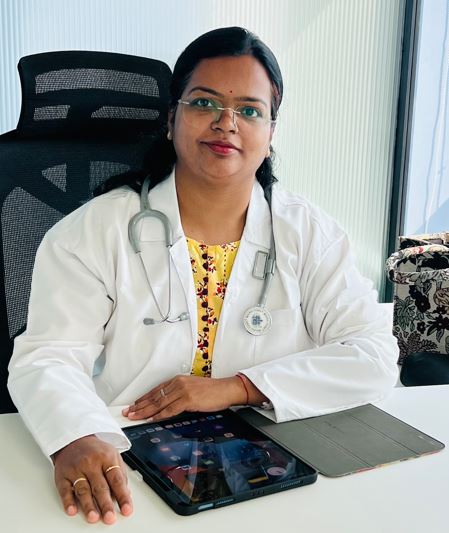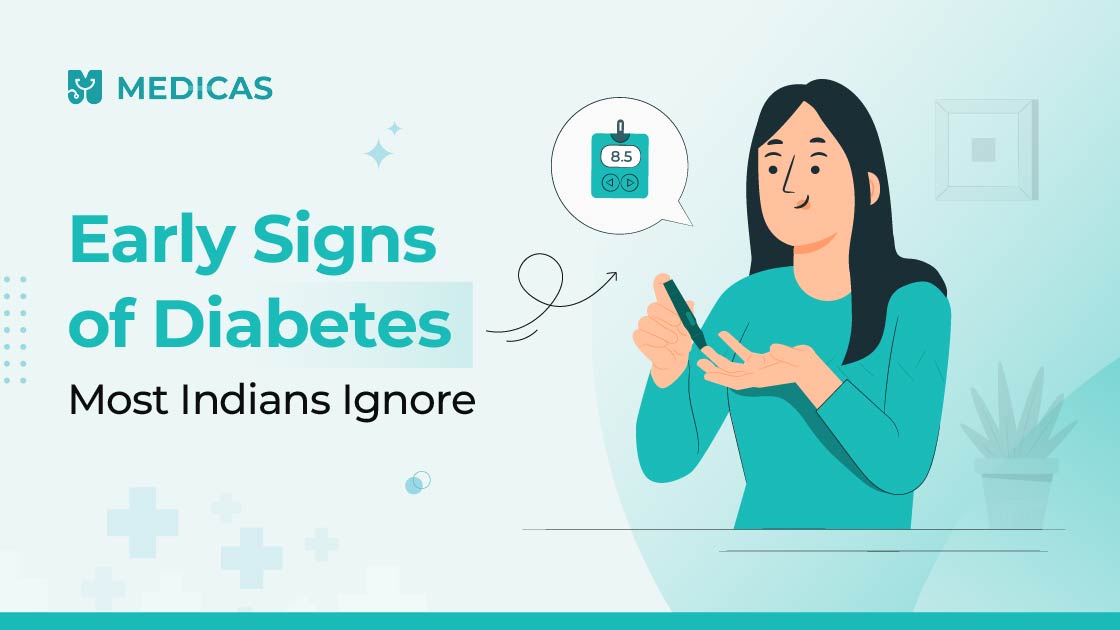Think diabetes only shows up with high sugar readings and medication? Think again. In many cases, the early signs of diabetes are subtle and often ignored—especially in India, where busy lifestyles and dietary habits can mask the warning signals. Fatigue after meals? Constant thirst? Unexpected weight changes? These could be your body’s quiet way of saying, “Pay attention!” In this blog, we’ll explore the diabetes symptoms that frequently slip under the radar, especially among Indians, and what to do when you spot them.
Understanding what are the first signs of diabetes empowers early action. Left unchecked, these subtle signs can evolve into serious complications. Fortunately, with early detection and simple lifestyle changes, many people can prevent or delay the onset of full-blown diabetes. You can also learn more about diabetes types and risk factors in our blog Understanding Diabetes: Causes, Types, and Risk Factors.
Why Indians Are Missing the Early Symptoms of Diabetes
The problem isn’t awareness alone—it’s also how casually many of us brush aside fatigue or frequent urination, calling it “normal” for a busy life. Combine that with high-carb diets, sedentary routines, late-night dinners, and genetics, and it creates a silent buildup of sugar imbalance.
Here’s why most Indians miss out on the prediabetes symptoms or sugar-related warning signs:
-
Cultural normalisation of tiredness or weakness
-
Late diagnosis due to self-medication
-
Underestimating family history
-
Reliance on “feeling okay” as a health check
-
Confusion with thyroid or stress-related symptoms
For some, these signs are mistaken for anemia or stress. In others, they are overlooked entirely—until diabetes-related complications emerge. Understanding the role of nutrition in diabetes management can help reduce these risks earlier.
Most Common Early Signs of Diabetes in Adults
The common signs of diabetes are actually easy to spot—if you’re paying attention.
| Symptom | What You May Notice |
|---|---|
| Excessive thirst (Polydipsia) | Always needing water, even after drinking enough |
| Frequent urination (Polyuria) | Waking up at night to urinate, or peeing more often |
| Unexplained weight loss | Losing kilos without dieting or exercising |
| Persistent fatigue | Feeling tired even after proper rest |
| Blurred vision | Trouble focusing, vision changes off and on |
| Slow-healing wounds | Cuts or infections taking longer to heal |
| Increased hunger (Polyphagia) | Feeling hungry even after meals |
| Tingling or numbness in hands/feet | Especially common in the morning or late evening |
| Itchy skin or frequent infections | Often seen in folds like the underarms or groin |
These symptoms are more common in adults, but diabetes can affect children too—even infants. If you’re a parent, explore Early Signs of Type 1 Diabetes in Infants: What Every Parent Should Know to better understand how symptoms show up differently in babies.
If you wonder how to know if you have diabetes early, tracking these symptoms is the first step.
Overlooked Diabetes Symptoms You Shouldn’t Ignore
Sometimes, the body gives subtle signs that are easy to miss but just as important.
-
Darkened skin around the neck or underarms (Acanthosis Nigricans): May indicate insulin resistance, not just pigmentation.
-
Mood changes or irritability: Linked to fluctuating glucose levels.
-
Recurrent urinary tract infections (UTIs): More common in diabetic women.
-
Fruity-smelling breath: Caused by ketones, a sign of uncontrolled sugar levels.
These may not be classic red flags, but are increasingly seen in Indian patients as symptoms of sugar disease in India. If left unchecked, these signs may lead to more serious complications like gangrene in diabetes or eye issues such as diabetes-related dry eyes.
When to Consult a Doctor for Diabetes Symptoms
Don’t wait until you’re unwell. If you’re experiencing two or more of these early symptoms for a few weeks, it’s wise to act early.
You can start by booking lab tests through Medicas for blood sugar (FBS, PPBS, HbA1c) from the comfort of your home. If results are borderline or high, the next step is to book an appointment with a Diabetologist to understand your risk profile, medications if needed, and lifestyle adjustments.
You may also try online doctor consultation if you’re unsure whether your symptoms need in-person attention or further lab testing.
How to Get Tested for Diabetes at Home
Checking your sugar levels at home is easier than ever. Here’s how you can do it:
-
Purchase a reliable blood glucose meter from a pharmacy.
-
Follow the instructions carefully: prick your finger and apply a small drop of blood to a test strip.
-
Record your readings before and after meals.
-
Maintain a symptom diary alongside readings (fatigue, thirst, urination) for your doctor’s review.
If levels stay high, it’s time to book lab tests for confirmation.
Lifestyle Tips to Manage Prediabetes
If your doctor says you’re in the “pre-diabetic” stage, don’t panic. Many people reverse or delay full diabetes by making timely changes.
Balanced Diet
Focus on a diet rich in whole grains, fruits, vegetables, and lean proteins.
-
Complex carbs: Whole grains, millets, pulses
-
Low-glycaemic fruits: Apples, guava, berries
-
Lean proteins and healthy fats: Fish, chicken, nuts, olive oil
For personalised help, consider dietary counseling for diabetes. Avoid sugary drinks and processed foods as much as possible.
Regular Exercise
Aim for 30 minutes of moderate activity (brisk walking, cycling) five days a week. How Pilates Can Benefit People With Diabetes – The Ultimate Guide shares safe and effective exercise strategies.
Weight Management
Losing even a modest amount of weight can significantly improve insulin sensitivity. Focus on portion control and mindful eating.
Stress Reduction
Chronic stress can impact blood sugar levels. Practice yoga, meditation, or deep breathing to bring it down naturally.
Adequate Sleep
Sleep deprivation can affect blood sugar regulation. Ensure 7–8 hours of uninterrupted sleep every night.
If you’ve been managing type 2 diabetes and are unsure about progression, explore Can Type 2 Diabetes Turn Into Type 1?
Family History Matters: Why Screening Your Loved Ones is Crucial
Diabetes often runs in families, and genetics play a significant role in determining your risk. If you have a parent, sibling, or close relative with diabetes, it’s important not just to monitor your own health but to encourage early screening for your family members as well.
In India, where prediabetes symptoms often go unnoticed due to lifestyle and dietary norms, family-based screening can help detect cases earlier—before complications arise.
Encouraging your loved ones to get tested can:
-
Help catch early signs of diabetes before symptoms become severe
-
Enable lifestyle changes that prevent progression
-
Reduce the risk of heart, kidney, and nerve complications in the long term
You can book convenient at-home lab tests for your family or encourage them to consult a diabetologist to assess their risk.
Conclusion: Don’t Ignore the Early Signs
Ignoring subtle shifts—thirst, fatigue, blurred vision—can allow prediabetes to slip into full-blown diabetes. Recognising early signs of diabetes and acting with diet, exercise, and professional monitoring is key. Whether you start with simple home remedies, try an online doctor consultation for advice, or book lab tests for confirmation, taking timely steps helps you stay ahead of complications.
FAQs About Diabetes Symptoms
What are the first warning signs of diabetes?
Early markers include increased thirst and urination, unexplained weight loss, persistent fatigue, and blurred vision.
Are the early symptoms of diabetes different in men and women?
While core symptoms—thirst, fatigue—are similar, women may notice more recurrent yeast infections and mood swings, whereas men may experience early erectile dysfunction.
Can I have diabetes without feeling sick?
Yes, diabetes can develop silently with no symptoms, making regular screening essential.
How can I check for diabetes symptoms at home?
Use a glucometer for fasting and post-meal readings. Note symptoms like thirst or fatigue. Share this log during an online consultation or clinic visit.
When should I see a doctor for diabetes-related symptoms?
See a doctor if fasting glucose repeatedly exceeds 100 mg/dL, post-meal is above 140 mg/dL, or if you have persistent symptoms. Book an appointment with a diabetologist for personalised care.
Disclaimer
Medical Advice: The information provided in this blog post is for educational purposes only and should not be considered as a substitute for professional medical advice, diagnosis, or treatment. Always consult with a qualified healthcare professional for personalized guidance regarding your specific medical condition.
Accuracy of Information: While we strive to provide accurate and up-to-date information, the field of medicine and viral fevers is constantly evolving. The content in this blog post may not reflect the most current research or medical guidelines. Therefore, it is advisable to cross-check any information provided with reliable sources or consult a healthcare professional.
Individual Variations: The symptoms, causes, treatment options, and preventive measures discussed in this blog post are general in nature and may not apply to everyone. It is important to remember that each individual’s situation is unique, and personalized medical advice should be sought when making healthcare decisions.
External Links: This blog post may contain links to external websites or resources for additional information. However, we do not endorse or have control over the content of these third-party websites. Accessing these links is done at your own risk, and we are not responsible for any consequences or damages that may arise from visiting these external sources.
Results May Vary: The effectiveness of treatment options or preventive measures mentioned in this blog post may vary from person to person. What works for one individual may not work the same way for another. It is essential to consult with a healthcare professional for personalized advice tailored to your specific needs.

Dr. Pratibha Shukla is a Diabetologist and Family Physician based in Mumbai, Maharashtra, with 8 years of clinical experience. She holds an MBBS, along with additional certifications including AFIH, PGDFM, CCEBDM, CCCS, and CCCMH, with a focus on diabetes care, family medicine, and occupational health. Dr. Shukla has worked with organizations such as ONGC, RCF Ltd., BARC Hospital, and under NHM programs, gaining experience in both clinical and community healthcare. Her expertise includes the management of diabetes, endocrine disorders, and chronic lifestyle diseases.


